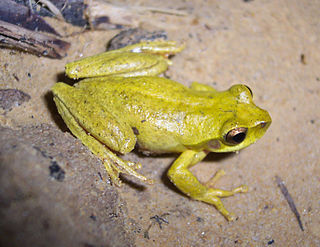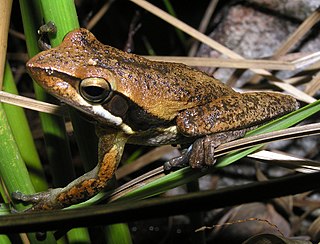
Ranoidea chloris, commonly known as the red-eyed tree frog or orange-eyed tree frog, is a species of tree frog native to eastern Australia; ranging from north of Sydney to Proserpine in mid-northern Queensland.

Tyler's tree frog or the southern laughing tree frog is an arboreal tree frog. It is native to eastern Australia. It occurs from southeast Queensland to the south coast of New South Wales. It is generally a coastal species and is not found inland.

The bleating tree frog, also known as Keferstein's tree frog, is a tree frog in the family Pelodryadidae. This frog is native to coastal eastern Australia, from south-eastern Queensland, to around Eden, New South Wales.

The Blue Mountains tree frog is a species of tree frog in the family Pelodryadinae. It is endemic to southeastern Australia and is found in eastern Victoria and in southeastern New South Wales. The Jenolan Caves tree frog, a population formerly separated as Litoria jenolanensis, is nowadays included in this species.

The leaf green tree frog is a species of stream-dwelling frog, native to eastern Australia from the Queensland/New South Wales border south to Sydney.

The revealed tree frog or whirring tree frog, is a species of tree frog native to coastal eastern Australia.

The dainty green tree frog, also known as the graceful tree frog, is a tree frog native to eastern Queensland, and north-eastern New South Wales, Australia. It ranges from northern Cape York in Queensland to Gosford in New South Wales, with a small and most likely introduced population in Hornsby Heights in Sydney. It is the faunal emblem of the City of Brisbane.

The striped rocket frog, or in its native range known as the rocket frog, occurs mostly in coastal areas from northern Western Australia to around Gosford in New South Wales at its southernmost point, with a disjunct population occurring further south at the Sydney suburb of Avalon. It also inhabits the southern lowlands and south east peninsula of Papua New Guinea.

Leptopelis vermiculatus, also known as the peacock tree frog, Amani forest treefrog, or vermiculated tree frog, is a species of frog found in forest areas in Tanzania. Sometimes the common name big-eyed tree frog is used, but this may also refer to another species, Leptopelis macrotis.

The striped burrowing frog is a species of burrowing frog in the family Pelodryadidae. It occurs throughout much of Australia, from northern New South Wales, through eastern and northern Queensland and into eastern Northern Territory. This species was once included in the genus Litoria or Cyclorana.

The Booroolong frog is a species of stream-dwelling frog native to the Great Dividing Range in New South Wales.

The motorbike frog is a ground-dwelling tree frog of the family Pelodryadidae found in Southwest Australia. Its common name is derived from the male frog's mating call, which sounds similar to a motorbike changing up through gears; it is also known as Moore's frog, the western bell frog, western green and golden bell frog, and western green tree frog.

Ranoidea australis, commonly known as the giant frog, northern snapping frog, or round frog, is a burrowing species native to Australia. It occurs from western Queensland through to northern Western Australia.

Roth's tree frog or the northern laughing tree frog is a tree frog native to northern Australia and southern Papua New Guinea. Roth's tree frog is a common frog, closely related to Peron's tree frog and Tyler's tree frog.

The slender tree frog is a tree frog native to southwestern Australia.

Hyla annectans is a species of tree frog in the family Hylidae. It is found in Asia south of the Himalayas in northeast India, northern Myanmar, and northern montane Vietnam and southwestern and central China. There are isolated records in northwestern Thailand and adjacent Myanmar. There is uncertainty whether Hyla gongshanensis from China should be recognized as a distinct species. This widespread species has many common names: Jerdon's tree frog, Assam treefrog, Indian hylid frog, green leave frog, or Southwestern China treefrog.

The Australian waterfall frog or torrent treefrog is a species of tree frog native to Far North Queensland, Australia. The common name "waterfall frog" is indicative of its habitat of moist, rocky streams, and is often found along waterfalls within its range.

Ranoidea wilcoxii is a species of frog in the family Pelodryadidae. Also known as the stony-creek frog, eastern stony creek frog and Wilcox's frog, it is endemic to Australia, being found solely on the eastern coast between Ingham, QLD, and Sydney, NSW, and as far west as Atherton, QLD. Its natural habitats are subtropical or tropical dry forests, subtropical or tropical moist lowland forests, rivers, intermittent rivers, and pastureland.

Pristimantis actinolaimus is a frog species in the family Craugastoridae. It is endemic to Colombia and only known from the vicinity of its type locality, El Estadero, in Samaná, Caldas Department, on the eastern slopes of the Cordillera Central. The specific name actinolaimus is derived from the Greek aktinos (=ray) and laimos (=throat) and refers to the radiating lines on the throat of this frog.

Cornufer citrinospilus is a species of frog in the family Ceratobatrachidae. It is endemic to the island of New Britain, Papua New Guinea, and is only known from the Nakanai Mountains of East New Britain Province. The specific name citrinospilus is derived from the Greek words kitrinos (="yellow") and pilos, in reference to the distinctive bright yellow flank areolations characteristic of this species.






















